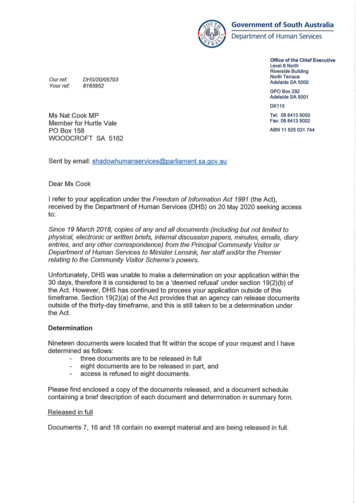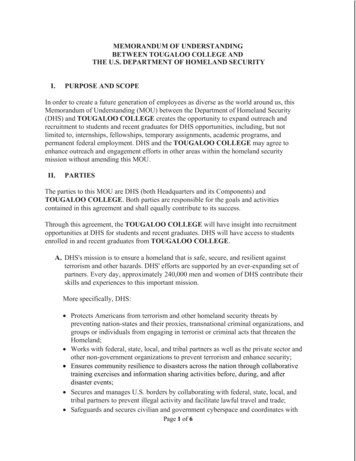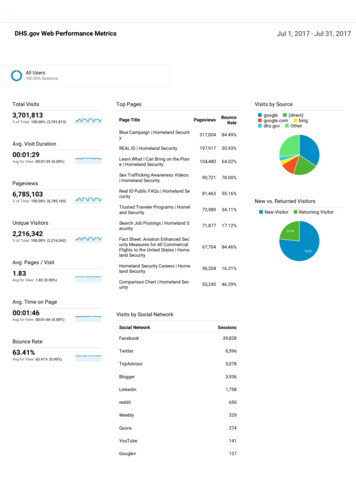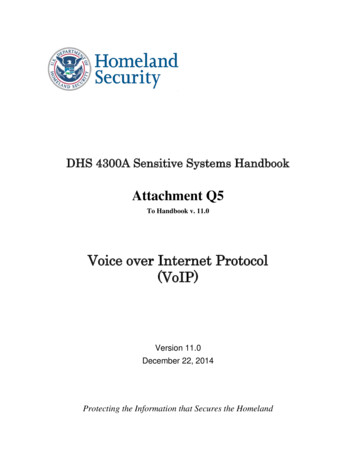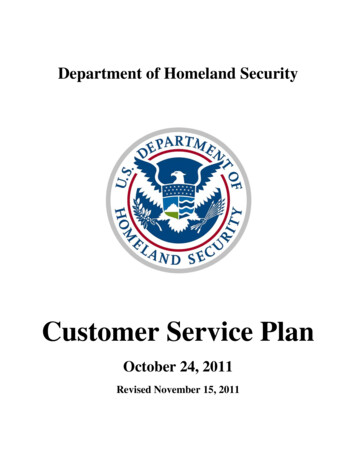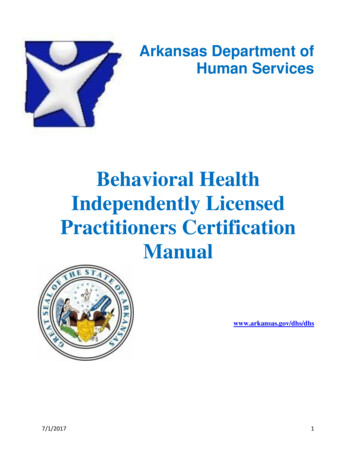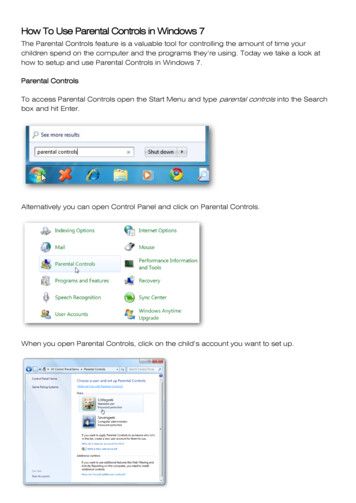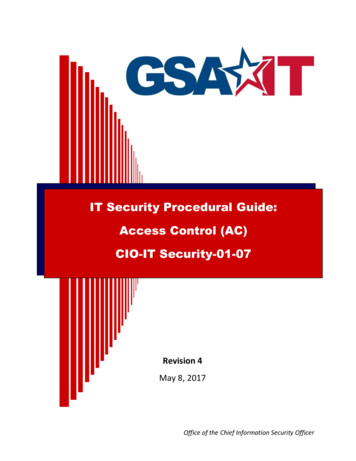
Transcription
DEPARTMENT OF HOMELAND SECURITYOffice of Inspector GeneralReview of DHS Security Controls forPortable Storage DevicesOIG-08-95September 2008
Office of Inspector GeneralU.S. Department of Homeland SecurityWashington, DC 20528September 26, 2008PrefaceThe Department of Homeland Security, Office of Inspector General, was established bythe Homeland Security Act of 2002 (Public Law 107-296) by amendment to the InspectorGeneral Act of 1978. This is one of a series of audit, inspection, and special reportsprepared as part of our oversight responsibilities to promote economy, efficiency, andeffectiveness within the department.The report identifies measures that can be taken by the Department of Homeland Securityto minimize the risk of theft, mishandling of the department’s sensitive information, orunauthorized use of portable storage devices. It is based on interviews with employeesand officials of relevant agencies and institutions, direct observations, discovery scans,and a review of applicable documents.The recommendations herein have been developed to the best knowledge available to ouroffice, and have been discussed in draft with those responsible for implementation. It isour hope that this report will result in more effective, efficient, and economicaloperations. We express our appreciation to all of those who contributed to thepreparation of this report.Richard L. SkinnerInspector General
Table of Contents/AbbreviationsExecutive Summary .1Background .2Results of Audit .4Unauthorized Devices Have Been Connected to DHS Systems.4Recommendations.5Management Comments and OIG Analysis .5Security Policies Should Be Implemented.6Recommendation .8Management Comments and OIG Analysis .8Implementation of OMB-Required Controls Can Minimize Risk.9Recommendation .10Management Comments and OIG Analysis .10AppendicesAppendix A: Purpose, Scope, and Methodology.11Appendix B: Management Comments to the Draft Report .12Appendix C: Major Contributors to this Report .17Appendix D: Report I&AICENPPDOMBS&TTSAUSBUSCGUSSSCustoms and Border ProtectionCitizenship and Immigration ServicesDepartment of Homeland SecurityFederal Emergency Management AgencyFederal Information Processing StandardsFederal Law Enforcement Training CenterIntelligence and AnalysisImmigration and Customs EnforcementNational Protection and Programs DirectorateOffice of Management and BudgetScience and TechnologyTransportation Security AdministrationUniversal Serial BusUnited States Coast GuardUnited States Secret ServiceReview of DHS Security Controls for Portable Storage Devices
OIGDepartment of Homeland SecurityOffice of Inspector GeneralExecutive SummaryWe evaluated the use of portable storage devices at the Departmentof Homeland Security (DHS). Our objective was to determinewhether DHS has addressed the emerging security threat from theproliferation of portable storage devices. We also followed-up onthe actions DHS has taken in response to Office of Managementand Budget (OMB) Memorandum 06-16 (M-06-16), Protection ofSensitive Agency Information. The proliferation and uncontrolleduse of portable storage devices (e.g., flash drives, external harddrives, and portable music players) increases the risk of theft andmishandling of sensitive information when users insert theirpersonal or unauthorized devices into their agencies’ computers’Universal Serial Bus (USB) or FireWire ports.DHS has taken actions to address the threat of the unauthorizedaccess to its sensitive information from the proliferation ofportable storage devices. For example, DHS has establishedpolicies on the acceptable use of portable storage devices. Inaddition, DHS is evaluating a technical solution that will encryptinformation stored on all recordable media.We determined, however, that the policies developed have notbeen implemented by the components. Specifically, componentsdo not have a centralized process to procure and distribute portablestorage devices to ensure that only authorized devices that meet thetechnical requirements can connect to its systems. In addition,most components have not identified and do not maintain aninventory of authorized devices. Further, the devices sampledwere not properly marked to protect the information stored onthese devices from mishandling. Finally, DHS has notimplemented all M-06-16 controls, despite the fact that it has beentwo years since OMB’s milestone has elapsed.We recommend that components identify and establish aninventory of authorized devices; implement controls to ensure thatonly authorized devices can connect to DHS systems; and performdiscovery scans, at least annually, to identify unauthorized devices.Finally, DHS should devote additional resources to implementOMB M-06-16 controls expeditiously. The department’s responseReview of DHS Security Controls for Portable Storage DevicesPage 1
is summarized and evaluated in the body of this report andincluded, in its entirety, as Appendix B.BackgroundThe proliferation and uncontrolled use of portable storage devicesincrease the risk of theft and mishandling of sensitive information.This condition is most prevalent when users insert their personal orunauthorized devices into a computer’s USB or FireWire ports.Examples of portable storage devices include flash drives, pendrives, external hard drives, and portable music and video players,such as iPods that can also be used to store data. These portabledevices are small enough to fit into a shirt pocket, relativelyinexpensive, and can be used to store a large amount of data. Thefeatures that make these devices popular can also introduce newsecurity risks and amplify risks that already existed with floppydisks. Shown below are examples of various portable storagedevices:Portable Storage DevicesThe risks of theft and mishandling of sensitive data stored onportable storage devices became more apparent when severalincidents were reported in 2006. For example, local police in NewMexico seized three USB flash drives that contained classifiedgovernment information from the Los Alamos National Laboratoryat a contract employee’s home. Additionally, stolen U.S. militaryflash drives that contained records about military operations andReview of DHS Security Controls for Portable Storage DevicesPage 2
individual soldiers were found being sold at a street market inAfghanistan.In response to the above and a series of other incidents involvingthe compromise or loss of sensitive personal information, OMBissued M-06-16, Protection of Sensitive Agency Information. Thismemorandum recommends measures to compensate for the lack ofphysical security controls when sensitive information is removedor accessed from outside the agency location. Agencies wererequired to implement the following measures by August 7, 2006: Encrypt sensitive data stored on laptop computers andmobile computing devicesEstablish two-factor authentication for remote accessconnectionsEnable the timeout feature for remote access after 30minutes of inactivityLog all data extracts from databases holding sensitiveinformation, and ensure that copies of extracts made byusers or administrators are erased within 90 days if theyare no longer needed.Fieldwork was performed at Citizenship and Immigration Services(CIS), Customs and Border Protection (CBP), Federal Emergencyand Management Agency (FEMA), Federal Law EnforcementTraining Center (FLETC), Immigration and Customs Enforcement(ICE), Intelligence and Analysis (I&A), Management Directorate(Management), National Protection and Programs Directorate(NPPD), Science and Technology (S&T), Transportation SecurityAdministration (TSA), United States Coast Guard (USCG), andUnited States Secret Service (USSS). We performed discoveryscans, using USBDetect software,1 to identify whetherunauthorized devices had been connected to DHS’ unclassifiedsystems at 11 components and five international airports located inCalifornia, Florida, Maryland, and Virginia.2 In addition, weperformed scans on selected classified systems at FEMA, I&A,and S&T.1USBDetect is a software tool that was developed by the National Security Agency. The tool gathers datafrom the registry on Microsoft Windows machines and reports whether storage devices, such as portablemusic and video players, external hard drives, flash drives, jump drives, and thumb drives, etc., have beenconnected to the USB ports.2We only evaluated the use of portable storage devices on selected classified systems at I&A.Review of DHS Security Controls for Portable Storage DevicesPage 3
Results of AuditUnauthorized Devices Have Been Connected to DHS SystemsDHS has implemented an effective process to ensure that onlyauthorized devices are connected to its classified systems.Specifically, system administrators have disabled the USB ports torestrict portable storage devices from connecting to DHS’classified systems. However, DHS has not implemented effectivecontrols to restrict unauthorized devices from being connected toDHS’ unclassified systems.Based on our discovery scans, we identified instances wherestorage devices and portable music and video players wereconnected to selected unclassified servers and workstations at the11 component offices included in our testing. Though we couldnot determine when these devices were connected or whether anysensitive information had been copied to these devices, DHS’controls did not restrict users from connecting unauthorizeddevices to the department’s unclassified systems.The discovery of unauthorized devices being connected to DHS’information systems is an indication that the controls implementedmay not be effective in restricting DHS’ sensitive data fromauthorized access or theft. Furthermore, while few components(CBP, Management, TSA, USCG, and USSS) performed discoveryscans to determine whether unauthorized devices had beenconnected to their systems, there is no set schedule that outlines thefrequency of the scans. Unless effective controls are implemented,increased risks exist for the potential mishandling or misuse ofDHS’ sensitive information stored on portable storage devices.According to DHS officials, the department recognized the threatsfrom the proliferation and uncontrolled use of portable storagedevices. DHS has recently begun to evaluate a new technicalsolution, which will automatically encrypt any recordable media(such as USB flash drives, external hard drives, portable music andvideo players, and CDs/DVDs) that have been inserted into DHSsystems. Once the encryption is applied, users can only accesssensitive information stored on these devices when they areconnected to DHS systems. With the new technical solution, theofficials indicated that there would be no need to maintain aninventory of authorized devices or ensure that the devices beingReview of DHS Security Controls for Portable Storage DevicesPage 4
used meet certain technical specifications. Furthermore, theofficials said that deploying the new technical solution would be acheaper alternative than purchasing portable storage devices with abiometric encryption feature.DHS does not have a timeline in implementing the new solution.According to the officials, DHS plans to deploy the new solutiondepartment-wide once its technical evaluation is completed and theresults are satisfactory. We believe that once the new technicalsolution is implemented, it can minimize the threats of thepotential mishandling or misuse of DHS’ sensitive information.RecommendationsWe recommend that the Chief Information Officer direct the components’Chief Information Officers to:Recommendation #1: Establish a process to ensure that only authorizedportable storage devices can connect to DHS systems. In addition,awareness training should be provided to users to educate them on therisks associated with the use of portable storage devices.Recommendation #2: Implement stringent technical controls to ensurethat unauthorized devices are not connected to DHS systems. Discoveryscans should be performed, at least annually, to identify unauthorizeddevices.Management Comments and OIG AnalysisDHS concurred with recommendation 1. DHS acknowledged thedeficiency in its current hardware and network settings that mayallow users to connect non-approved devices to DHS equipmentand networks. Additionally, DHS restated its current policy thatemployees and contractors are prohibited from using anynon-government issued removable media (e.g., USB flash drives)or connecting them to DHS equipment and networks or to storeDHS sensitive information. All DHS-issued USB flash drivesmust be FIPS 197 compliant and have received FIPS 140-2validation to protect the information stored on these devices. Inaddition, DHS plans to implement a technical solution withWindows Vista and Windows Server 2008. Finally, DHS statedthat its users are already being educated on the risks associatedwith the use of portable storage devices, as part of the currentsecurity awareness training.Review of DHS Security Controls for Portable Storage DevicesPage 5
We agree that the steps DHS plans to take satisfy thisrecommendation. DHS did not provide an estimated timeframe todeploy Windows Vista and Windows Server 2008. DHS’ sensitivedata continues to be at risk until the department implements aneffective process to ensure that only authorized portable storagedevices can connect to its systems. Specifically, the results ofdiscovery scans revealed that relying on policy alone does notrestrict or deter users from connecting their personal music andvideo players (e.g., iPod) to DHS systems. While connecting aniPod to a DHS system is a violation of existing DHS policy, it isconfirmation that a deficiency exists in the department’s currenthardware and network settings which allows users to connectnon-approved devices to DHS equipment and networks. It mayalso be an indicator that the current security awareness trainingmay not be effective in educating users on the risks associated withthe use of portable storage devices.DHS concurred with recommendation 2. DHS agreed that the useof portable storage devices (e.g., USB flash drives) should becontrolled. Currently, DHS restricts the use of portable storagedevices through policy, security awareness training, and disablingUSB ports on workstations. DHS indicated that more stringentcontrols are available through Windows Vista and through GroupPolicy Objects in Microsoft Server 2008. Specifically, adeployment of Vista and Server 2008 has the capability to restrictUSB device installation by Device ID and Device Class. TheDevice ID matches the exact make, model, and revision of thedevice, such as a particular USB drive model and manufacturer.Finally, DHS agreed that discovery scans should be performedannually to detect unauthorized devices.We agree that the steps DHS plans to take satisfy thisrecommendation. DHS should deploy an interim solution torestrict the unauthorized use of portable storage devices untilWindows Vista and Windows Server 2008 are implemented.During our review, we determined that USB ports were onlydisabled on some classified workstations.Security Policies Should Be ImplementedDHS has developed policies to mitigate the risks associated withthe use of portable storage devices on both classified andunclassified systems. For example, DHS requires that informationstored on portable storage devices be encrypted in accordance withReview of DHS Security Controls for Portable Storage DevicesPage 6
FIPS 140-2 standards.3 In addition, DHS prohibits the use ofpersonal devices on DHS systems. Furthermore, DHS requiresthat all recordable media, including authorized portable storagedevices, must be properly marked indicating the data’sclassification, such as “For Official Use Only (FOUO),” “Secret,”or “Top Secret,” etc.Several major components (CBP, FLETC, ICE, NPPD, TSA, andUSCG) have developed policies, which are aligned with DHS’guidance regarding the use of portable storage devices. However,neither DHS nor the components’ policies have been implementedfully. Specifically, we identified: Portable storage devices are authorized for use at 11 of the12 components visited.4 However, none of these 11components have established a centralized process toprocure and distribute these devices. A centralized processis essential to ensure that only devices that meet DHS andcomponents’ technical requirements are used to processand store sensitive information. FEMA and I&A prohibit the use of portable storagedevices on their classified systems. CBP, CIS, FEMA, FLETC, ICE, Management, NPPD,S&T, and USCG did not maintain inventories of authorizeddevices. CBP, CIS, ICE, and NPPD indicated that aninventory was not maintained because the monetary valuefor these portable devices was below the threshold. Whenan inventory is not maintained, DHS and its componentscannot track the use of these devices or ensure that onlyauthorized devices are connected to their networks. CIS, FEMA, FLETC, ICE, Management, NPPD, S&T,USCG, and USSS did not apply “marking” on the devicessampled to protect sensitive information stored on thesedevices from being mishandled. Applying proper markingcan minimize the risks associated with the accidentaldisclosure of sensitive data stored on portable storagedevices.3This standard is applicable to all Federal agencies that use cryptographic-based security systems to protectsensitive information in computer and telecommunications systems. FIPS 140-2, Security RequirementsFor Cryptographic Modules, dated May 25, 2001.4We did not evaluate the use of portable storage devices on I&A’s unclassified systems. We onlyevaluated the use of these devices on classified systems located in an I&A sensitive compartmentedinformation facility.Review of DHS Security Controls for Portable Storage DevicesPage 7
The implementation of specific policies is essential to ensure thatsensitive information stored on portable storage devices isprotected from unauthorized use, theft, or mishandling. To protectagainst threats involving potential misuse, it is imperative thatDHS and its components establish a centralized process to procureand distribute portable storage devices, maintain an inventory ofauthorized devices, and apply proper marking to protectinformation stored on these devices from unauthorized disclosure.RecommendationWe recommend that the Chief Information Officer direct the components’Chief Information Officers to:Recommendation #3: Identify the manufacturers and models ofauthorized devices. Ensure that an inventory, which contains the names ofmanufacturers and serial numbers of devices, is maintained. The devicesshould be marked to indicate the data classification to protect sensitiveinformation stored from unauthorized disclosure or mishandling.Management Comments and OIG AnalysisDHS concurred with recommendation 3. DHS stated that aninventory of authorized portable storage devices can be establishedunder the Windows Vista and Windows Server 2008 environment,as the Device ID for all authorized USB devices can be identified.However, this capability does not include the identification ofserial numbers for USB devices. As this solution is not availableuntil DHS is operating in a Vista and Server 2008 environment,DHS has identified standards for USB flash drives, which requiresthese devices be FIPS 140-2 and FIPS 197 compliant. Finally,DHS restated its policy requirement to have appropriate markingson storage media.We agree that the steps DHS plans to take satisfy thisrecommendation. However, DHS does not plan to establish aninventory of its authorized portable storage devices until WindowsVista and Windows Server 2008 are implemented. In addition,DHS does not plan additional actions to enforce its current policyto ensure these devices are properly marked to indicate the dataclassification to protect sensitive information stored fromunauthorized disclosure or mishandling.Review of DHS Security Controls for Portable Storage DevicesPage 8
Implementation of OMB-Required Controls Can Minimize RiskIn January 2007, we reported that DHS and its components were inthe process of implementing OMB’s recommended securitycontrols for sensitive data and personally identifiable information(PII) as outlined in M-06-16.5 During this evaluation, wefollowed-up on the actions taken to implement these controls at 11components and determined that DHS has not completed theimplementation of the required OMB controls to protect itssensitive data from unauthorized access.6The purpose of OMB M-06-16 was to compensate for the lack ofphysical security controls when sensitive information is removedor accessed from outside the agency location. The implementationof these controls can also minimize the risks of unauthorizedaccess to the sensitive data stored on portable storage devices.Specifically, we identified: Ten of the 11 components have installed encryptionsoftware to protect sensitive information stored on theirlaptopsSeven of the 11 components implemented the sessiontime-out function which requires users tore-authenticate after 30 minutes of inactivityOnly 5 of the 11 components have implementedtwo-factor authentication7None of the 11 components tested implementedeffective controls or a reliable process to ensure thatdata extracts are erased within 90 days or when nolonger needed.Despite some progress in implementing OMB-required controls,more attention and resources may be needed to ensure thatsensitive data stored on laptops and mobile computing devices isprotected from unauthorized access. Further, DHS officials needto develop milestones for implementing OMB M-06-16. Until5DHS’s’ Implementation of Protective Measures for Personally Identifiable Information (OIG-07-24,January 2007).6We performed fieldwork at 12 components. However, the National Institute of Standards and TechnologySpecial Publication 800-53, Recommended Security Controls for Federal Information Systems, controlsoutlined in OMB M-06-16 do not apply to I&A’s classified systems.7Two-factor authentication is a security process in which the user provides two means of identification,one of which is typically a physical token, such as a card, and the other of which is typically somethingmemorized.Review of DHS Security Controls for Portable Storage DevicesPage 9
these controls have been implemented, there is an increased riskthat sensitive data may be compromised through the loss or theft oflaptop computers and mobile computing devices.RecommendationWe recommend that the Chief Information Officer direct the ChiefInformation Security Officer to:Recommendation #4: Devote additional resources to ensure the controlsoutlined in OMB M-06-16 are implemented expeditiously.Management Comments and OIG AnalysisDHS did not concur with recommendation 4. DHS did not agreethat the OIG should direct the Chief Information Officer onallocating its resources. However, the Chief Information Officeracknowledged that resources must be identified to implement thesecontrols. DHS indicated that implementation plans were beingdeveloped based on risks and cost analysis.We maintain our position that it has been two years since OMB’smandated milestone has elapsed and that DHS should ensurecontrols outlined in OMB M-06-16 are implemented expeditiously.We would note as well that we are not directing anything regardingthe allocation of resources at DHS. Rather, we are recommendingthat the Chief Information Officer direct the Chief InformationSecurity Officer to devote additional resources to implement OMBrequired security controls. It is well within our responsibility,when conducting audits, to identify areas where increasedresources are needed to resolve the deficiency.Also, in a final comment, the Chief Information Officer expressedconcern that the title of the draft report, DHS Must Address theEmerging Security Threat from the Proliferation of PortableStorage Devices, predisposes readers to think that the departmenthas not taken any action in that regard. We agree and have revisedthe title as requested.Review of DHS Security Controls for Portable Storage DevicesPage 10
Appendix APurpose, Scope and MethodologyOur objective was to determine whether DHS has addressed theemerging security threat from the proliferation of portable storagedevices. We also followed-up on the actions DHS has taken inresponse to Office of Management and Budget (OMB)Memorandum 06-16 (M-06-16), Protection of Sensitive AgencyInformation.To accomplish our audit, we interviewed selected personnel atCBP, CIS, FEMA, FLETC, ICE, Management, NPPD, I&A, S&T,TSA, USCG, and USSS. In addition, we reviewed and evaluatedDHS’ and components’ security policies and procedures regardingthe use of portable storage devices. We performed discoveryscans, using USBDetect software, to identify whether unauthorizeddevices had been connected to DHS’ unclassified systems at 11components (CBP, CIS, FEMA, FLETC, ICE, Management,NPPD, S&T, TSA, USCG, and USSS) and five internationalairports located in California, Florida, Maryland, and Virginia. Inaddition, we performed scans on selected classified systems atFEMA, I&A, and S&T.We conducted our evaluation between February and May 2008,under the authority of the Inspector General Act of 1978, asamended, and according to the Quality Standards for Inspectionsissued by the President’s Council on Integrity and Efficiency(PCIE). Major OIG contributors to the audit are identified inAppendix C.The principal OIG points of contact for the audit are Frank Deffer,Assistant Inspector General, Office of Information Technology at(202) 254-4100; and Edward G. Coleman, Director, InformationSecurity Audits Division at (202) 254-5444.Review of DHS Security Controls for Portable Storage DevicesPage 11
Appendix BManagement Comments to the Draft ReportReview of DHS Security Controls for Portable Storage DevicesPage 12
Appendix BManagement Comments to the Draft ReportReview of DHS Security Controls for Portable Storage DevicesPage 13
Appendix BManagement Comments to the Draft ReportReview of DHS Security Controls for Portable Storage DevicesPage 14
Appendix BManagement Comments to the Draft ReportReview of DHS Security Controls for Portable Storage DevicesPage 15
Appendix BManagement Comments to the Draft ReportReview of DHS Security Controls for Portable Storage DevicesPage 16
Appendix CMajor Contributors to this ReportInformation Security Audit DivisionEdward Coleman, DirectorChiu-Tong Tsang, Audit ManagerMike Horton, Information Technology OfficerBarbara Bartuska, Audit ManagerCharles Twitty, Audit Team LeaderNazia Khan, IT SpecialistThomas Rohrback, IT SpecialistMelissa Keaster, ReferencerReview of DHS Security Controls for Portable Storage DevicesPage 17
Appendix DReport DistributionDepartment of Homeland SecuritySecretaryDeputy SecretaryChief of StaffDeputy Chief of StaffGeneral CounselExecutive SecretaryAssistant Secretary for PolicyAssistant Secretary for Office of Public AffairsAssistant Secretary for Office of Legislative AffairsChief Information OfficerDeputy Chief Information OfficerChief Information Security OfficerDirector, Compliance and OversightDirector, GAO/OIG Liaison OfficeChief Information Officer Audit LiaisonChief Information Security Officer Audit ManagerOffice of Management and BudgetChief, Homeland Security BranchDHS OIG Budget ExaminerCongressCongressional Oversight and Appropriations Committees, asappropriateReview of DHS Security Controls for Portable Storage DevicesPage 18
Additional Information and CopiesTo obtain additional copies of this report, call the Office of Inspector General(OIG) at (202) 254-4199, fax your request to (202) 254-4305, or visit the OIG website at www.dhs.gov/oig.OIG HotlineTo report alleged fraud, waste, abuse or mismanagement, or any other kind ofcriminal or noncriminal misconduct relative to department programs oroperations: Call our Hotline at 1-800-323-8603;Fax the complaint directly to us at (202) 254-4292;Email us at DHSOIGHOTLINE@dhs.gov; orWrite to us at:DHS Office of Inspector General/MAIL STOP 2600, Attention:Office of Investigations - Hotline, 245 Murray Drive, SW, Building 410,Washington, DC 20528.The OIG seeks to protect the identity of each writer and caller.
portable storage devices can connect to DHS systems. In addition, awareness training should be provided to users to educate them on the risks associated with the use of portable storage devices. Recommendation #2: Implement stringent technical controls to ensure that unauthorized devices are not connected to DHS systems. Discovery
